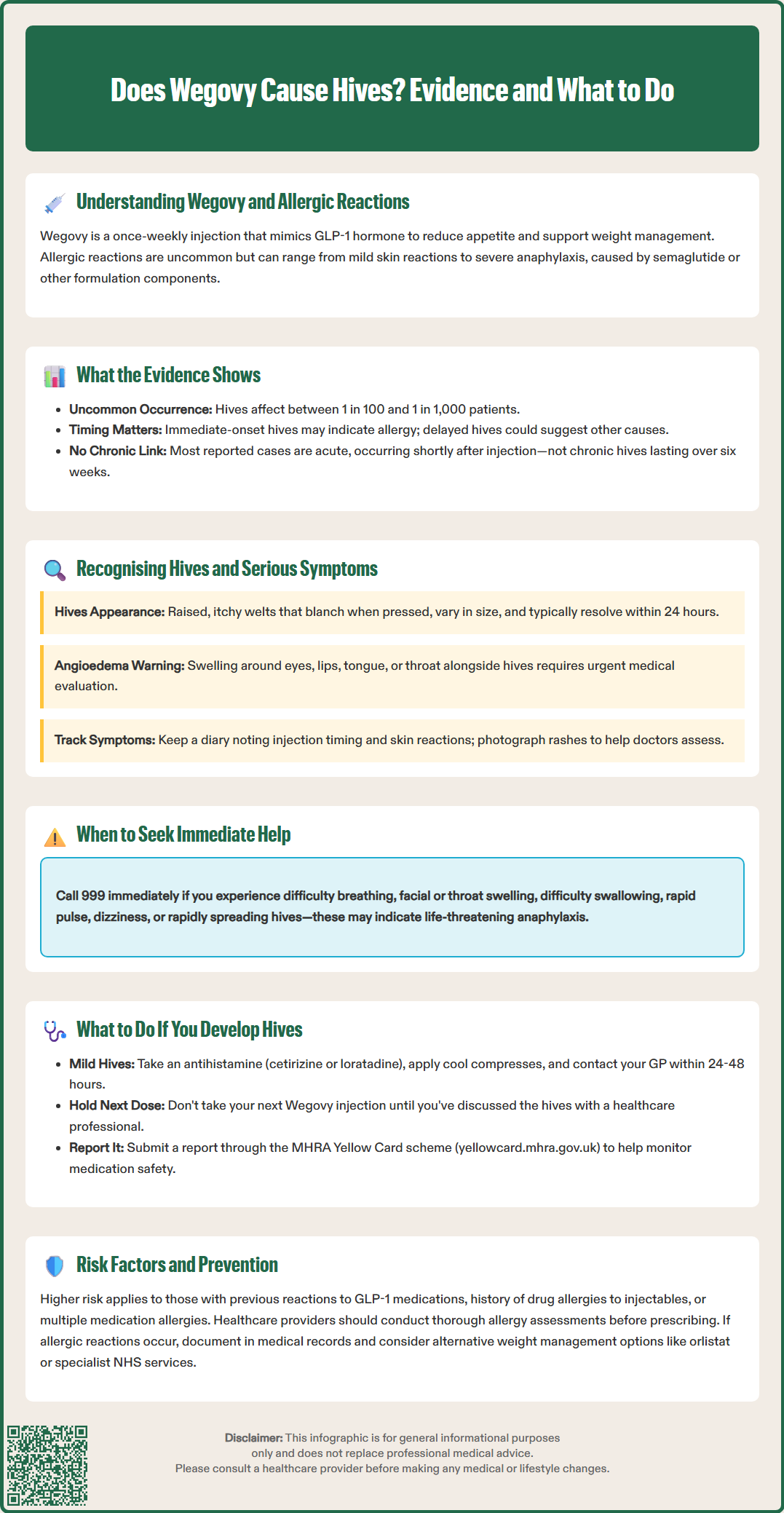
Wegovy (semaglutide 2.4 mg) is a glucagon-like peptide-1 (GLP-1) receptor agonist licensed in the UK for weight management in adults with obesity or overweight with weight-related comorbidities. Whilst generally well tolerated, some patients may experience allergic reactions, including hives (urticaria). Understanding whether Wegovy causes hives, how to recognise allergic symptoms, and when to seek medical attention is essential for patient safety. This article examines the evidence linking Wegovy to hives, explores risk factors, and provides practical guidance on managing potential allergic reactions in line with UK regulatory guidance from the MHRA and NICE recommendations.
Quick Answer: Wegovy can cause hives (urticaria), though this hypersensitivity reaction is uncommon, affecting between 1 in 100 and 1 in 1,000 patients according to the Summary of Product Characteristics.
Wegovy (semaglutide 2.4 mg) is a glucagon-like peptide-1 (GLP-1) receptor agonist licensed in the UK for weight management in adults with obesity or overweight with weight-related comorbidities. Administered as a once-weekly subcutaneous injection, Wegovy works by mimicking the naturally occurring hormone GLP-1, which regulates appetite and food intake through actions on the brain's satiety centres, whilst also slowing gastric emptying and improving glycaemic control.
As with any medication, Wegovy carries the potential for adverse reactions, including allergic responses. Allergic reactions to medications can range from mild skin manifestations to severe, life-threatening anaphylaxis. The Medicines and Healthcare products Regulatory Agency (MHRA) monitors all reported adverse events associated with Wegovy to ensure patient safety and provide updated guidance to healthcare professionals.
Hypersensitivity reactions to GLP-1 receptor agonists, whilst uncommon, have been documented in clinical practice and are listed in the Summary of Product Characteristics (SmPC). These reactions may be directed against the active pharmaceutical ingredient (semaglutide itself) or excipients within the formulation. Understanding the distinction between common, expected side effects—such as gastrointestinal symptoms—and genuine allergic reactions is essential for both patients and clinicians.
Patients commencing Wegovy should be counselled about potential adverse effects during their initial consultation, as recommended in NICE Technology Appraisal 875. Healthcare professionals must take a thorough allergy history before prescribing, particularly noting any previous reactions to GLP-1 receptor agonists or structurally similar medications. Early recognition of allergic symptoms enables prompt intervention and prevents progression to more serious complications. Suspected adverse reactions should be reported via the MHRA Yellow Card scheme.

Hives (urticaria) are raised, itchy welts on the skin that result from histamine release during allergic or hypersensitivity reactions. According to the Wegovy SmPC, hypersensitivity reactions including urticaria can occur, though the frequency is classified as uncommon (affecting between 1 in 100 and 1 in 1,000 patients).
Clinical trial data from the STEP (Semaglutide Treatment Effect in People with obesity) programme, which included over 4,500 participants, documented hypersensitivity reactions including urticaria in a small proportion of patients. The pivotal STEP 1 trial (Wilding et al., 2021) and subsequent safety analyses provide the evidence base for these observations. Post-marketing surveillance data collected by the MHRA and European Medicines Agency (EMA) have similarly identified isolated reports of hives associated with semaglutide use, though establishing definitive causality remains challenging given the multiple factors that can trigger urticaria.
It is important to distinguish between reactions occurring shortly after injection and delayed presentations. Immediate-onset hives following Wegovy injection may suggest an allergic mechanism, whilst delayed presentations may indicate other immunological processes or coincidental urticaria unrelated to the medication. Specialist assessment is recommended for suspected drug allergy.
There is no official link establishing Wegovy as a common cause of chronic urticaria (hives lasting more than six weeks). Most reported cases involve acute urticaria appearing shortly after injection. The SmPC for Wegovy lists hypersensitivity reactions, including urticaria, amongst recognised adverse effects, confirming that whilst possible, such reactions are not frequent occurrences. Importantly, the SmPC states that treatment should be discontinued immediately and patients should seek prompt medical advice if a severe allergic reaction occurs. Patients experiencing hives should not automatically assume Wegovy is responsible without proper medical assessment, as urticaria has numerous potential triggers including foods, infections, and other medications.

Mounjaro® is the most innovative GLP-1 medication proven to dramatically curb appetite, hunger, and cravings to help professional men achieve substantial weight loss.
Start Here
Wegovy® is a weekly injectable GLP-1 medication with proven effectiveness in reducing appetite, hunger, and cravings to help busy professionals lose significant weight.
Start HereHives typically present as:
Raised, red or skin-coloured welts (wheals) that blanch when pressed
Intense itching (pruritus), often worse at night
Welts that vary in size from a few millimetres to several centimetres
Lesions that may join together to form larger areas of raised skin
Symptoms that can appear anywhere on the body
Individual welts that typically resolve within 24 hours, though new ones may continue to appear
When hives occur as part of an allergic reaction to Wegovy, they may be accompanied by other symptoms that warrant careful attention. Angioedema—swelling of deeper skin layers, particularly around the eyes, lips, tongue, or throat—represents a more concerning manifestation that requires urgent medical assessment. The combination of hives with angioedema suggests a more significant hypersensitivity reaction.
Warning signs of a severe allergic reaction (anaphylaxis) include:
Difficulty breathing, wheezing or hoarseness
Swelling of the face, lips, tongue, or throat
Difficulty swallowing
Rapid pulse or palpitations
Dizziness or feeling faint
Severe abdominal pain or vomiting
Stridor (high-pitched sound when breathing)
Patients should also be aware that injection site reactions—including redness, itching, or swelling localised to the injection area—are relatively common with Wegovy (affecting up to 1 in 10 patients according to the SmPC) and do not necessarily indicate systemic allergy. These localised reactions typically resolve spontaneously within a few days and differ from widespread hives affecting multiple body areas.
Keeping a symptom diary noting the timing of Wegovy injections and any skin reactions can help healthcare professionals determine whether hives are genuinely medication-related or coincidental. Photographic documentation of rashes proves particularly valuable during consultations. For more information on recognising hives and allergic reactions, the NHS website provides patient-friendly guidance on urticaria and anaphylaxis.
If you develop hives whilst taking Wegovy, the appropriate response depends on the severity and associated symptoms. For mild, isolated hives without other concerning features:
Take an over-the-counter antihistamine such as cetirizine (10 mg once daily) or loratadine (10 mg once daily) to relieve itching
Apply cool compresses to affected areas
Avoid hot baths or showers, which can worsen itching
Wear loose, comfortable clothing
Document when the hives appeared in relation to your Wegovy injection
Contact your GP or prescribing clinician within 24–48 hours for advice
If your GP is unavailable and you need advice, contact NHS 111
Do not administer your next scheduled Wegovy dose until you have discussed the reaction with a healthcare professional. Continuing the medication without medical guidance could risk a more severe reaction.
Seek immediate medical attention (call 999 or attend A&E) if you experience:
Difficulty breathing or swallowing
Swelling of the face, lips, tongue, or throat
Feeling faint or dizzy
Rapid heartbeat
Severe abdominal pain
Hives rapidly spreading across large body areas
These symptoms may indicate anaphylaxis, a medical emergency requiring immediate treatment with intramuscular adrenaline. According to the Wegovy SmPC, treatment should be discontinued immediately if a severe allergic reaction is suspected.
Following emergency treatment for a suspected allergic reaction, you may be referred to an allergy specialist for further assessment, in line with NICE Clinical Guideline 134 (Anaphylaxis). If you've experienced a severe reaction, you might be prescribed an adrenaline auto-injector as a precaution.
Your healthcare provider will conduct a thorough assessment to determine whether Wegovy is the likely cause of your hives. This may involve reviewing your medication history, recent dietary changes, new personal care products, or concurrent illnesses. If Wegovy is identified as the probable trigger, your clinician will discuss alternative weight management strategies. The MHRA encourages reporting of suspected adverse drug reactions through the Yellow Card scheme (yellowcard.mhra.gov.uk), which helps monitor medication safety across the UK population. Your healthcare professional can submit a report on your behalf, or you can report directly via the Yellow Card website.
Certain factors may increase the likelihood of developing allergic reactions to Wegovy, though predicting individual risk remains imperfect. Potential risk factors include:
Previous allergic reactions to GLP-1 receptor agonists (such as liraglutide, dulaglutide, or exenatide)
History of drug allergies, particularly to injectable medications
Multiple drug allergies or documented hypersensitivity to various medications
Before prescribing Wegovy, healthcare professionals should conduct a comprehensive allergy assessment in line with NICE Clinical Guideline 183 (Drug Allergy). The Wegovy SmPC clearly states that patients with hypersensitivity to semaglutide or any of the excipients should not receive the medication. This includes patients with previous reactions to semaglutide formulations (including Ozempic, used for type 2 diabetes) due to cross-reactivity risk.
Strategies to minimise adverse effects include:
Ensuring proper injection technique to minimise local reactions
Following the recommended dose titration schedule (starting with 0.25 mg weekly) to improve gastrointestinal tolerability
Avoiding injection into areas with existing skin conditions or inflammation
Rotating injection sites (abdomen, thigh, or upper arm) to prevent localised reactions
Maintaining the medication at appropriate storage temperature (2–8°C before first use; after first use, can be stored at up to 30°C for 28 days; do not freeze)
It's important to note that while dose titration and proper technique can reduce local and gastrointestinal side effects, they do not prevent true allergic reactions in susceptible individuals. NICE guidance (TA875) on obesity management emphasises the importance of regular follow-up during pharmacological treatment, allowing early detection of adverse effects.
Patients should inform all healthcare providers about their Wegovy use. If you have experienced hives or allergic reactions to Wegovy, ensure this is documented in your medical records and consider wearing medical alert identification. Referral to an allergy specialist is appropriate for suspected drug allergy, while dermatology referral may be needed if urticaria persists for more than six weeks (chronic urticaria).
Alternative weight management approaches, including other pharmacological agents (such as orlistat) or referral to specialist NHS weight management services (Tier 3 or 4), should be discussed with your healthcare team if Wegovy proves unsuitable due to allergic reactions. Note that some alternatives, such as naltrexone-bupropion, are not routinely recommended by NICE for NHS use (TA494).
Hives (urticaria) are classified as an uncommon adverse effect of Wegovy, affecting between 1 in 100 and 1 in 1,000 patients according to the Summary of Product Characteristics. Clinical trial data from the STEP programme documented hypersensitivity reactions including urticaria in a small proportion of participants.
Do not administer your next scheduled Wegovy dose until you have discussed the reaction with a healthcare professional. If hives are accompanied by difficulty breathing, facial swelling, or other severe symptoms, seek immediate medical attention by calling 999 or attending A&E, as these may indicate anaphylaxis.
Injection site reactions (redness, itching, or swelling localised to the injection area) are relatively common with Wegovy, affecting up to 1 in 10 patients, and typically resolve within a few days. Hives (urticaria) are raised, itchy welts that can appear anywhere on the body and may indicate a systemic allergic reaction requiring medical assessment.
All medical content on this blog is created based on reputable, evidence-based sources and reviewed regularly for accuracy and relevance. While we strive to keep content up to date with the latest research and clinical guidelines, it is intended for general informational purposes only.
DisclaimerThis content is not a substitute for professional medical advice, diagnosis, or treatment. Always consult a qualified healthcare professional with any medical questions or concerns. Use of the information is at your own risk, and we are not responsible for any consequences resulting from its use.